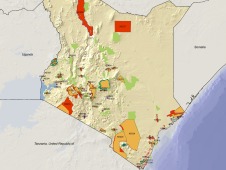| Using IBAs to inform the CBD Programme of Work on Protected Areas (PoWPA) | |
 |
Countries are obligated through the CBD Programme of Work on Protected Areas (PoWPA) to identify gaps in their national protected area systems. Comparing the locations of Important Bird Areas (IBA) with those of existing protected areas is a simple yet effective way of finding where key species are left unprotected and can greatly assist countries in meeting their PoWPA commitments. |
The Convention on Biological Diversity (CBD) has developed a comprehensive Programme of Work on Protected Areas (PoWPA) which aims to encourage countries to establish and maintain comprehensive and ecologically representative networks of protected areas. To achieve this, the CBD has asked each Government to conduct a gap analysis to find out if, and where, their current protected area system falls short of adequately protecting its biodiversity.
Important Bird Areas (IBAs) are Key Biodiversity Areas (KBAs) identified using birds. They are selected through the application of internationally recognised criteria, based, as far as possible, on accurate and up-to-date knowledge of bird distributions and populations. BirdLife Partners have identified and mapped IBAs in nearly 200 countries and territories across the world.
Comparing the locations of IBAs with those of existing protected areas is a simple yet effective way of finding where key species are left unprotected or under-protected. Therefore, IBAs can show where there are gaps in the existing protected area network, helping CBD Parties implement PoWPA. To date, BirdLife has carried out this analysis and produced maps for over 80 countries around the world. These were created using information available on the distribution of IBAs and Protected Areas (the latter from the UNEP-WCMC World Database on Protected Areas).
For more information see the State of the world’s birds case study ‘Important Bird Areas can help inform an ecologically representative network of protected areas’.
The maps are available to download individually below and a selection can be found collectively in the booklet ‘Towards an ecologically representative network of protected areas’. To date, maps have only been produced for a selection of regions and countries. If you are interested in maps being produced for your country please contact us at science@birdlife.org.